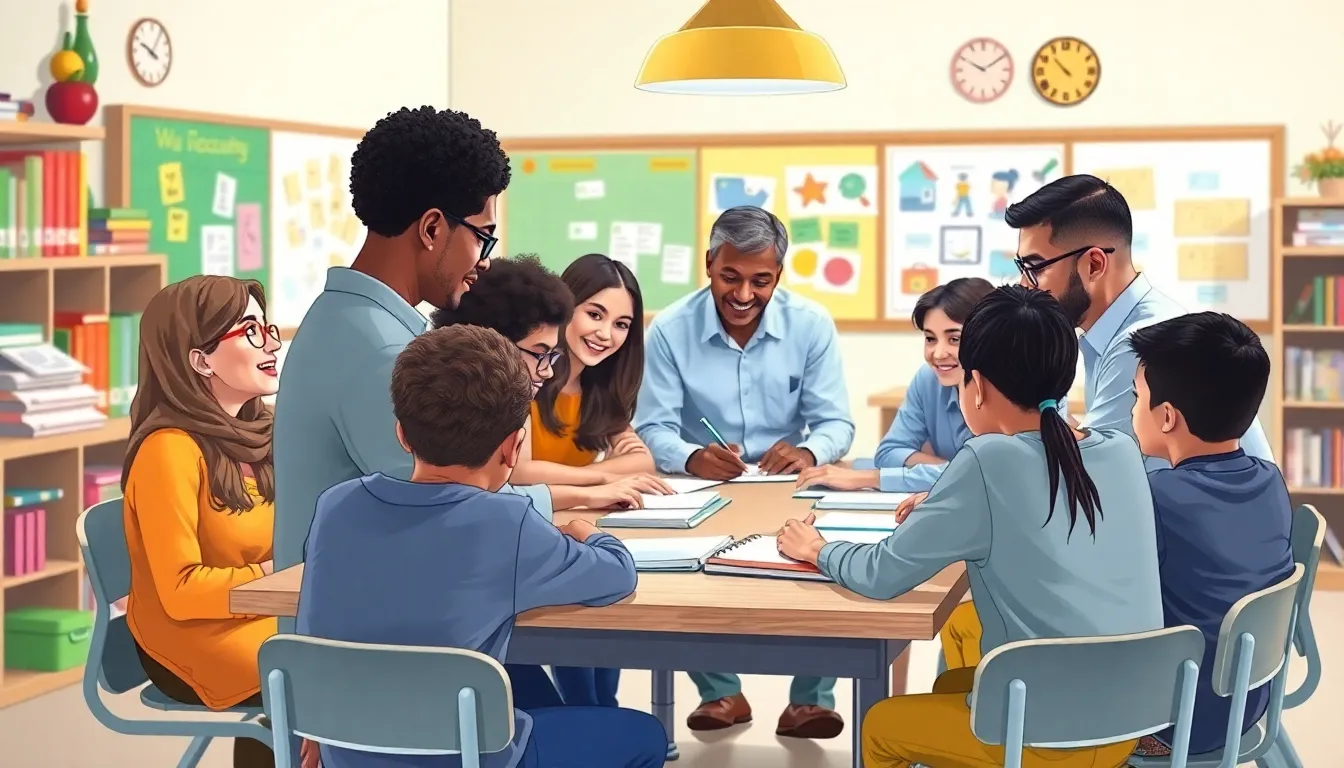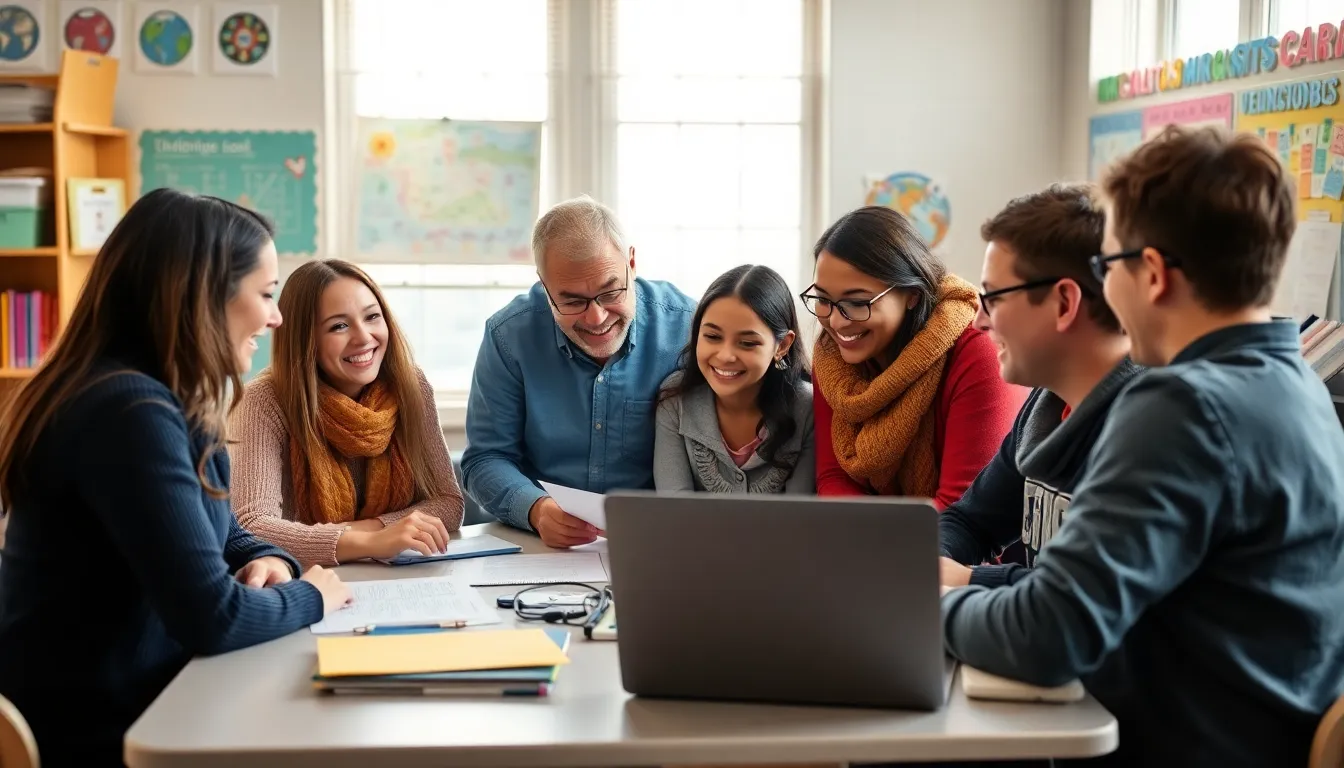In the world of education, parent-teacher collaboration is like the dynamic duo of Batman and Robin—each has their unique strengths, but together they can conquer any challenge. When parents and teachers join forces, students thrive in ways that would make even the most seasoned superhero proud. It’s not just about exchanging report cards; it’s about building a community where everyone plays a part in shaping young minds.
Imagine a classroom where parents and teachers communicate openly, share ideas, and tackle obstacles together. It’s a recipe for success that boosts student engagement and fosters a love for learning. So, let’s dive into the importance of this partnership and discover how a little collaboration can go a long way in creating an environment where every child can shine like a star in the night sky.
Table of Contents
ToggleImportance Of Parent-Teacher Collaboration
Parent-teacher collaboration plays a crucial role in student achievement. This partnership creates a sustainable support system, enhancing communication between home and school. Open dialogue fosters trust, leading to a better understanding of a child’s needs and strengths.
Shared responsibility helps create consistent messaging around academic expectations and behavior. Parents receiving regular updates can address learning challenges more effectively. Teachers, in turn, can suggest strategies for parents at home to reinforce school lessons.
Research indicates that strong collaboration between parents and teachers leads to improved academic performance. According to the National Education Association, students with involved parents achieve higher grades and test scores. Increased engagement in school activities also results from strong parent-teacher relationships.
Collaboration fosters a sense of community among families and staff. Community-building events allow parents and teachers to connect, promoting a supportive environment for students. Engaged families are more likely to advocate for their children’s educational needs.
Culturally responsive practices emerge from strong collaboration, adapting to diverse student backgrounds. Understanding various cultural perspectives helps teachers address unique challenges. This insight supports personalized learning plans, meeting the individual needs of every child.
Cultivating this partnership requires ongoing efforts. Schools can provide workshops that educate parents on how to support their child’s learning at home. Teachers benefit from professional development workshops to enhance communication strategies. Overall, prioritizing parent-teacher collaboration benefits students, ensuring they have the foundation to excel academically and socially.
Benefits For Students

Parent-teacher collaboration significantly impacts student success. This partnership leads to enhanced academic performance and social-emotional health.
Academic Achievement
Involved parents contribute to higher grades and better test scores. Students thrive when teachers and parents communicate about academic expectations. Coordination of efforts ensures consistent support for learning, both at home and in school. Effective strategies help address individual learning challenges. Research indicates that strong collaboration correlates with improved academic outcomes, creating a conducive learning environment. Regular updates on student progress empower parents to engage meaningfully, reinforcing concepts taught in the classroom.
Social-Emotional Development
Collaboration between parents and teachers nurtures social-emotional skills. Open communication builds trust, providing students with a safety net for expressing feelings. As parents and teachers work together, they model healthy relationships, promoting conflict resolution and effective communication skills. Schools that prioritize this collaboration create inclusive environments, where students feel valued and supported. Engaging in joint community events fosters a sense of belonging among families, enriching students’ overall school experience. Emotional support from both parents and teachers enhances resilience and encourages positive behaviors.
Strategies For Effective Collaboration
Effective collaboration between parents and teachers relies on intentional strategies. Prioritizing specific approaches can enhance engagement and foster meaningful partnerships.
Communication Techniques
Establishing clear channels of communication strengthens collaboration. Regular emails and texts keep parents informed about classroom activities and important announcements. Scheduled parent-teacher conferences provide opportunities for in-depth discussions on student progress. Teachers can also utilize online platforms for sharing resources and updates, making information easily accessible. Furthermore, creating a feedback loop encourages parents to share insights about their child’s needs, fostering a two-way dialogue. Engaging in active listening promotes understanding, as both parties work together to support student success.
Involvement Opportunities
Offering various involvement opportunities invites parents into the school community. Volunteering for classroom events allows parents to witness first-hand educational practices. Workshops on specific topics, such as literacy or math strategies, equip parents with tools to support learning at home. Parent-teacher organizations (PTOs) create additional avenues for involvement, enhancing communication among families and school staff. Hosting family nights or community events brings families together, building relationships and support networks. Providing diverse opportunities ensures that all parents feel welcomed and valued in the educational process.
Challenges In Collaboration
Parent-teacher collaboration faces several challenges that can hinder its effectiveness.
Time Constraints
Time limits often restrict both parents and teachers from engaging fully. Many parents juggle work, family responsibilities, and other commitments, leaving little room for school involvement. Teachers also manage busy schedules filled with lesson planning, grading, and meetings. These competing priorities can create barriers to meaningful communication and collaboration. Short interactions during pick-up or drop-off times fail to address deeper issues surrounding a child’s development. Structured events outside of school hours may offer better opportunities for discussions. Flexible meeting times or virtual options can assist in accommodating busy schedules while fostering connection.
Misunderstandings
Misunderstandings frequently arise due to varied expectations and communication styles. Parents may misinterpret a teacher’s feedback or perceive an email’s tone as unintentional. Similarly, educators might overlook key home dynamics that impact a child’s learning environment. These disconnects can lead to frustration or mistrust. Clear communication plays a vital role in bridging these gaps. Regularly scheduled meetings or check-ins encourage open dialogue, allowing all parties to express concerns and share perspectives. Utilizing common language and clear objectives enhances understanding and fosters a collaborative spirit.
Successful Collaboration Models
Effective parent-teacher collaboration follows several successful models that enhance communication and engagement. One approach involves collaborative planning, where teachers and parents work together to create action plans tailored to individual students’ needs. This model fosters a sense of shared responsibility for student outcomes.
Another model is the regular communication check-in. Scheduled updates enable parents and teachers to discuss academic progress, behavioral concerns, and strategies that promote effective learning at home. Consistent dialogue strengthens relationships between schools and families.
Workshops represent a hands-on collaboration strategy. Offering workshops for both parents and teachers encourages professional development while equipping families with tools to support their children’s education. These gatherings build community while aligning efforts toward student success.
Involving parents in school decision-making processes enhances their investment in the educational experience. This model allows parents to contribute input on policies or events, fostering a sense of ownership over their children’s learning environment. Collaborative opportunities empower parents and teachers to work in tandem.
Lastly, utilizing technology facilitates ongoing engagement. Online platforms for sharing resources and communication streamline connections between parents and teachers. These digital tools can contain progress reports, event calendars, and discussion forums, making it easy to interact.
Prioritization and adaptation to diverse family backgrounds matter. Culturally responsive practices align educational strategies with families’ needs, enhancing collaboration outcomes. Schools that adopt these models cultivate an inclusive, supportive atmosphere conducive to learning.
Parent-teacher collaboration is essential for fostering a thriving educational environment. By working together, parents and teachers can create a unified approach to support students, enhancing both academic performance and emotional well-being. When communication flows freely and effectively, it builds trust and encourages active involvement from both parties.
This partnership not only enriches the learning experience but also cultivates a strong sense of community. As schools continue to prioritize collaboration, they pave the way for a brighter future for every child. Embracing this teamwork leads to a more engaged and successful student body, ultimately benefiting society as a whole.




